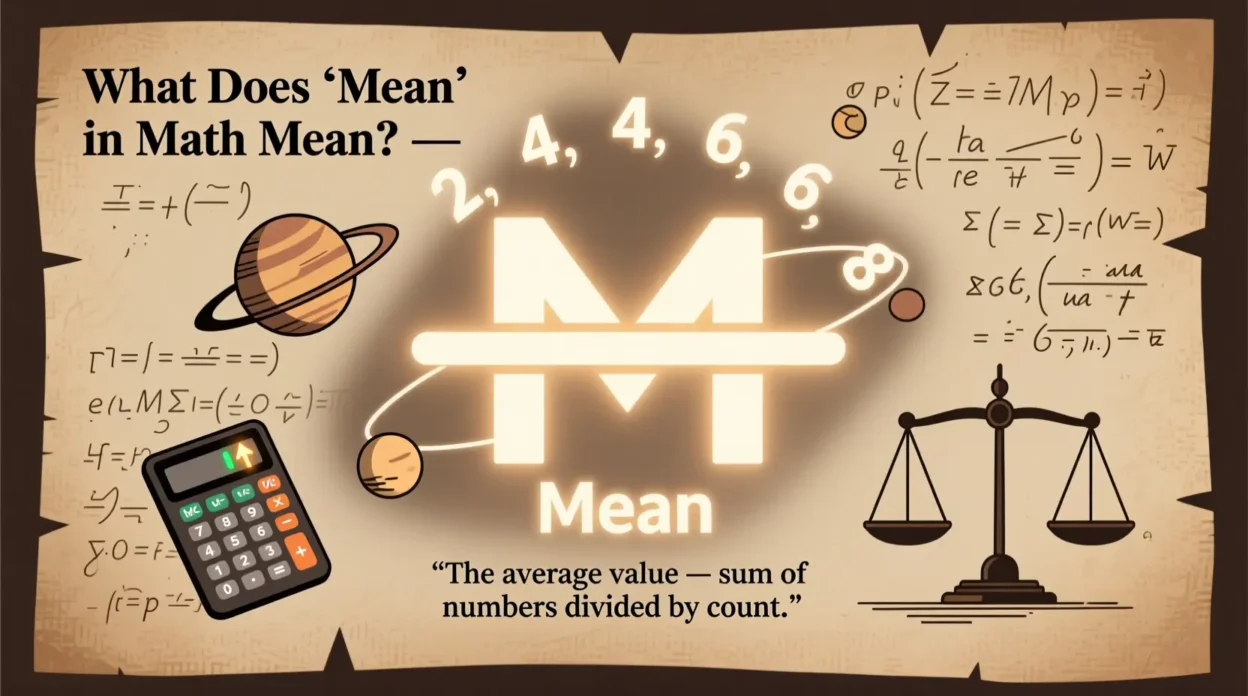Have you ever been in a math class or scrolling through a homework problem and wondered, “Wait… what does ‘mean’ actually mean?”
🤔 At first glance, it might seem like just another fancy word, but understanding it is simpler than you think.
In everyday conversation, “mean” can sound negative, but in math, it has a very precise and helpful definition.
Quick Answer: In math, the mean is the average of a set of numbers. It’s a neutral, friendly way to summarize data by finding a central value.
What Does “Mean” in Math Mean?
In mathematics, the mean is a measure of central tendency, often referred to as the average. It’s calculated by adding all the numbers in a data set together and then dividing the total by how many numbers there are.
Example:
If you have test scores: 80, 90, 70, 100, the mean would be: Mean=80+90+70+1004=3404=85\text{Mean} = \frac{80 + 90 + 70 + 100}{4} = \frac{340}{4} = 85Mean=480+90+70+100=4340=85
In short: Mean = Average = Sum of numbers ÷ Total numbers ✅
Where Is “Mean” Commonly Used?
The concept of mean is everywhere in math and everyday life:
- 📚 School assignments & exams – teachers often ask for the mean of a set of numbers.
- 📊 Statistics – used to analyze data in surveys, research, or sports.
- 💼 Business & Finance – calculating averages for sales, expenses, or profits.
- 🧪 Science & Experiments – summarizing measurements or results.
Tone: Neutral, formal in professional or academic use; friendly and casual in everyday learning contexts.
Examples of “Mean” in Math
Here are some real-life scenarios showing how mean is used:
- Scenario: Your friend asks about test scores.
- A: “Our scores were 75, 85, 90, and 95. What’s the mean?”
- B: “The mean is 86.25 🙂”
- Scenario: Calculating weekly expenses.
- A: “I spent $10, $15, $20, $25 last week. Mean?”
- B: “Mean = $17.50 💵”
- Scenario: Sports scores.
- A: “Our team scored 8, 12, 15, 10 in four games.”
- B: “Average (mean) = 11.25 ⚽”
- Scenario: Temperature tracking.
- A: “Temps this week: 70, 72, 68, 75, 74. Mean?”
- B: “Mean = 71.8° 🌡️”
- Scenario: Online learning forum.
- A: “Can someone explain mean to a beginner?”
- B: “Just add all numbers and divide by total — that’s the mean 👍”
When to Use and When Not to Use “Mean”
✅ When to Use:
- Calculating averages for grades, salaries, or prices.
- Summarizing data in reports or presentations.
- Comparing groups of numbers.
❌ When Not to Use:
- For very skewed or uneven data (median might be better).
- When only maximum or minimum values matter.
- In casual conversation when you mean “unkind” — not math context.
Comparison Table:
| Context | Example Phrase | Why It Works |
|---|---|---|
| Friend Chat | “Average score = 85 😄” | Casual & easy to understand |
| School Homework | “Calculate the mean of 10,12,15” | Neutral & educational |
| Business Report | “Mean revenue = $15,000” | Professional & clear |
| Scientific Paper | “The mean measurement was 5.2cm” | Formal & precise |
Similar Math Terms
| Term | Meaning | When to Use |
|---|---|---|
| Median | Middle number when data is ordered | Skewed datasets or outliers |
| Mode | Most frequent number in a set | Identify trends or common values |
| Range | Difference between max & min | Understand spread of data |
| Standard Deviation | Measure of data spread around mean | Statistical analysis |
FAQs:
Q1: Is mean the same as average?
✅ Yes! In most cases, “mean” and “average” are interchangeable.
Q2: Can mean be a decimal?
✅ Absolutely. The mean doesn’t have to be a whole number.
Q3: What’s the difference between mean, median, and mode?
- Mean: Average
- Median: Middle value
- Mode: Most frequent value
Q4: Why do we use mean?
✅ To summarize a data set with a single number that represents the “typical” value.
Q5: Can mean be used with negative numbers?
✅ Yes, just sum all numbers including negatives and divide by total numbers.
Conclusion:
Understanding mean in math is easier than it looks. By simply adding all numbers and dividing by how many there are, you can find the average of any data set.
Whether for school, work, or everyday life, knowing how to calculate the mean helps you make sense of numbers quickly and clearly. Next time you see “mean,” you’ll know exactly what it’s talking about!

